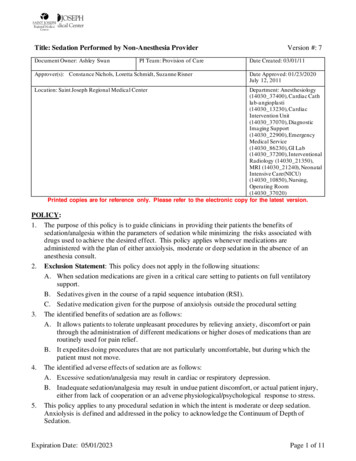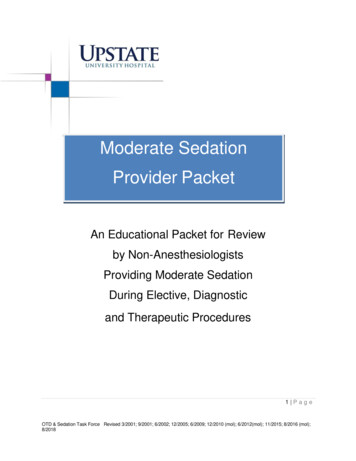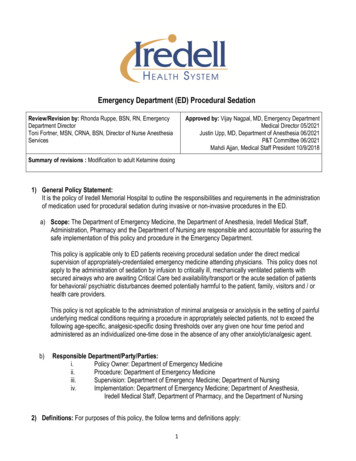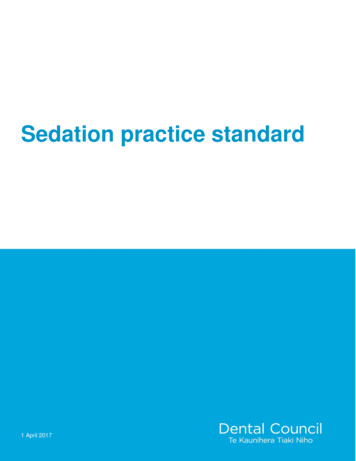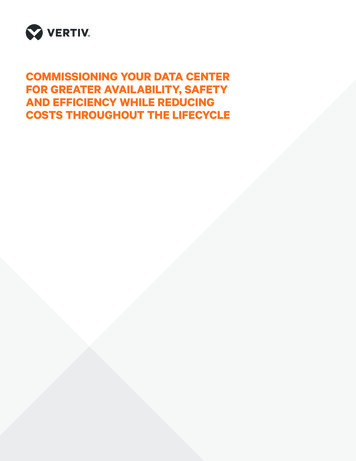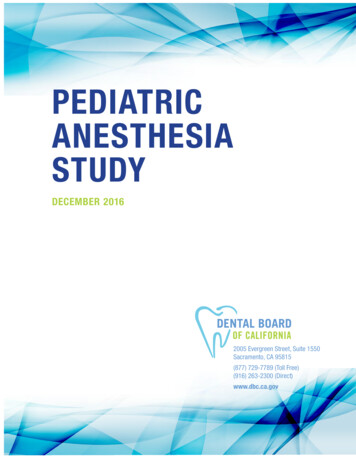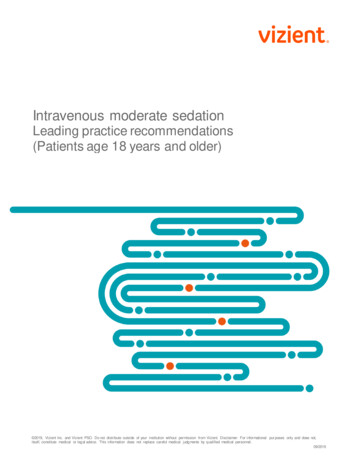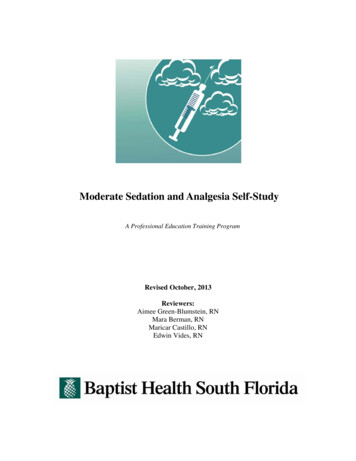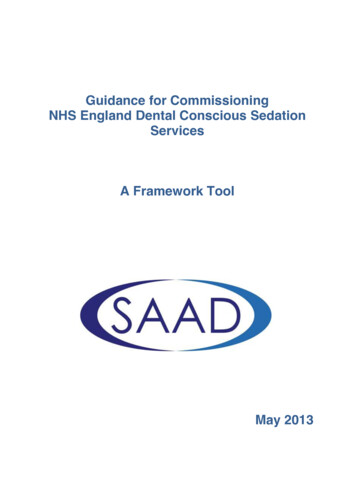
Transcription
Guidance for CommissioningNHS England Dental Conscious SedationServicesA Framework ToolMay 2013
Society for Advancement of Anaesthesia in Dentistry, May 2013Table of Contents1.2.3.4.5.6.7.8.9.10.11.12.13.Background . 2Introduction . 3Evidence Base . 3Aims of Service Design . 4Service Objectives . 4Definitions . 5Clinical Service Requirements . 5Service Delivery Model . 7Premises and Equipment . 12Performers and Workforce . .14Clinical Governance . 15Cost Recommendations .16Conclusions .18Appendix 1 - Recommended referral pattern for a locality 19Appendix 2 - Recommended data set .20Appendix 3 - Team training recommendations . 21Membership of the working party . 22Page 1
Society for Advancement of Anaesthesia in Dentistry, May 20131. BackgroundPain and anxiety control is central to modern ethical dental practice and should be apriority for all dental practitioners during the delivery of clinical care for their patients.Dental procedures are diverse in their nature and patients’ dental needs, anxiety levelsand medical conditions can vary greatly. This report provides an indication for a rangeof clinically justified management modalities, both non-pharmacological andpharmacological, which are available to dental professionals to assist patients incoping with dental treatment.Effective local anaesthesia and quality behavioural management techniques, togetherwith a calm, sympathetic manner should be at the core of all patient interactions andtherefore central to all dentists’ approach to patient care. However, there will alwaysbe a cohort of patients who are unable to cope with these simple techniques andrequire more complex techniques to allow then to accept invasive dental treatment.This leads to a necessity for the availability of appropriate, safe, predictable andeffective conscious sedation techniques within each geographical area which aredesigned to deliver care for those patients unable to access dental care in a routinemanner.It is imperative that dental sedation services operatewithin well governed and organised clinical networks,which have strong clinical leadership and are managedby well trained, experienced and dedicated teams ofdental professionals.Providing dental care under conscious sedation can be challenging due to the diverserange of patients’ needs and requirements related to levels of anxiety, the patient’sability to cope with treatment, co-morbidities and the proposed dental care. Thisrequires experienced clinicians to carry out detailed and thorough patient assessmentexploring all areas of the patient’s dental, medical and social history, and makeevidence-based decisions about the most appropriate treatment modality for thepatient. Clinicians need to have a good understanding and appreciation of allconscious sedation techniques and the use of general anaesthesia (GA) to supportquality and effective decision making that leads to the best possible patient outcomes.Sedation services need to be delivered by well organised facilities with highly trainedand experienced teams of dental professionals. These teams need to operate within aculture of regular feedback and be integrated into local and national organisationswithin NHS England. Regular quality assurance and clinical audits should be integralaspects of the management structures to ensure that premises, teams and treatmentare maintained at the highest possible standards and in accordance with currentnational guidance and best practice.This document adopts the principles of the World Health Organisation Surgical SafetyChecklist.Page 2
Society for Advancement of Anaesthesia in Dentistry, May 20132. IntroductionThis framework proposes a potential common approach to dental conscious sedation servicedelivery models throughout England.The framework aims to support the delivery of safe, high quality, patient-centred care whichencourages a system of robust and transparent quality assurance, and the appropriate use ofresources in a cost effective and evidence based manner.The framework supports a service design which encourages the use of a variety of conscioussedation techniques which has, at its core, the assessment process delivered by well-trainedand experienced dental sedationists capable of making robust and predictable decisionsregarding patient care.The guidance in this framework builds upon the recommendations in the Department ofHealth’s 2006 guidance document “Commissioning Conscious Sedation Services in PrimaryDental Care”.This document adopts the principles of the Mid Staffordshire NHS Foundation Trust Inquiry(The Francis Report), which recommends standards defined by the following statements:Fundamental standards of minimum safety and quality – in respect of which non-complianceshould not be tolerated. Failures leading to death or serious harm should remain offences forwhich prosecutions can be brought against organisations. There should be a defined set ofduties to maintain and operate an effective system to ensure compliance;Enhanced quality standards – such standards could set requirements higher than thefundamental standards but be discretionary matters for commissioning and subject toavailability of resources;Developmental standards which set out longer term goals for providers – these would focuson improvements in effectiveness and are more likely to be the focus of commissioners andprogressive provider leadership than the regulator.All such standards would require regular review and modification.It is essential that professional bodies in which doctors and nurses have confidence are fullyinvolved in the formulation of these standards and in the means of measuring compliance.3. Evidence BaseThis Service Specification takes into account best practice guidance: A Conscious Decision, Department of Health (2000)Conscious Sedation in the Provision of Dental Care, Standing Dental AdvisoryCommittee, Department of Health (2003)Standards for Conscious Sedation in Dentistry: Alternative Techniques, StandingCommittee on Sedation for Dentistry (2007)NICE: Sedation in Children and Young People (2010)NICE: Sedation in Children and Young People: Costing Report, ImplementingNICE guidance (2010)A guide to maintaining professional standards in conscious sedation for dentistry(2011) Independent Expert Group on Training Standards for Sedation in DentistryPage 3
Society for Advancement of Anaesthesia in Dentistry, May 2013 Safe Sedation Practice, Standardised Evaluation of Conscious Sedation Practicefor Dentistry in the UK – a toolkit for implementing National Standards, SAAD(2013)Guidelines for the Appointment of Dentists with a Special Interest (DwSI) inConscious Sedation, Department of Health/Faculty of General Dental Practice(UK) (2007)Commissioning Conscious Sedation Services in Primary Dental Care, Departmentof Health (2006)The Mid Staffordshire NHS Foundation Trust Public Inquiry, Chaired by RobertFrancis QC, February 2013 HC947WHO Surgical Safety ery/tools resources/SSSL Manual finalJun08.pdf4. Aims of FrameworkTo provide a comprehensive specialised dental conscious sedation referral service, meetingthe needs of any given population/region and manage dental treatment where conscioussedation is indicated. This service should run alongside regular GDS services and complimentlocal arrangements for secondary care general anaesthesia and special care dental services.Providers will be expected to play a leadership role, providing support to GDPs with respect toreferral criteria and operating within a managed clinical network supporting best practice andregular peer review.The aims for NHS Dental Conscious Sedation Service provision are: To provide access to high quality NHS Anxiety Management & Sedation Servicesfor local populations to ensure equity and consistency of provision To deliver appropriate, efficient and cost effective services To reduce the number of patients referred for general anaesthetic in secondary careTo improve patient choice through an increased range and availability of highly skilledproviders working within a well governed clinical network;To provide access to high quality anxiety management and sedation services that meet thespecific needs of the local population;To establish a positive working relationship between the local area teams (LATs) andproviders to facilitate and maximise service delivery; andTo develop services in line with the evolving local strategic approach to primary care dentalprovision and guidance from local professional networks (LPNs).5. Service ObjectivesTo provide a high quality specialised dental conscious sedation referral service for thosepatients who meet the referral criteria. There are a variety of clinical circumstances that mayindicate a the need for conscious sedation, including: Patients that are anxious or phobic Patients that have a strong gag reflex making it difficult to accept dental treatment Those patients with movement disorders, physical and/or mental disabilities, or whoare otherwise unlikely to allow safe completion of treatment To enable a particularly unpleasant and complicated procedure to be carried outwithout distress to the patientPage 4
Society for Advancement of Anaesthesia in Dentistry, May 2013 To avoid the need for general anaesthesia, for example in patients with longstanding dental phobia.To provide services that will ensure accessibility for all residents within the local region.To provide, where appropriate, access to a defined range of NHS general dental servicesunder conscious sedation, leading to an improvement in oral health.To provide a service that is delivered by suitably qualified support personnel, who areappropriately registered with their professional bodies.It is expected that all clinicians providing treatment will operate in accordance with agreedprotocols for assessment and treatment.6. DefinitionsIn the UK, conscious sedation is currently defined as:“a technique in which the use of a drug or drugs produces a state of depression of thecentral nervous system enabling treatment to be carried out, but during which verbalcontact with the patient is maintained throughout the period of sedation. The drugs andtechniques used to provide conscious sedation for dental treatment should carry a marginof safety wide enough to render loss of consciousness unlikely.”Conscious sedation should not be interpreted as light general anaesthesia. The use of anytechnique where there is loss of consciousness or protective reflexes is general anaesthesia,and GA is only permitted within an environment with facilities equivalent to an Acute NHSTrust. The drugs and techniques used in conscious sedation should therefore have a marginof safety wide enough to render loss of consciousness unlikely.7. Clinical Service RequirementsThe Dental Conscious Sedation Service will be delivered under a “hub and spoke” modelwhich manages a number of providers and delivers access to a two Tier structure of conscioussedation techniques (Appendix 1).Patient assessment must be undertaken by an experienced dental sedationist (such as apractitioner who fulfils the requirements of the DwSI document listed at section 3) withknowledge and appreciation of all available techniques. Patient assessment may occur in avariety of centres which may or may not provide both Tier 1 and Tier 2 techniques. Theintention is that Tier 1 services will be available through a network of centres, but that Tier 2services are likely to operate from a much smaller number of clinics, and potentially only onein any given locality in a spoke and hub arrangement. Tier 2 centres should also have Tier 1capabilities to reduce over-prescription of Tier 2 techniques.Page 5
Society for Advancement of Anaesthesia in Dentistry, May 2013Tier 1 services will provide basic conscious sedationtechniques: Inhalation sedation with nitrous oxide and oxygen.Intravenous sedation - the standard technique involves the administration of atitrated dose of a single drug.Oral and intranasal sedation - only be used by practitioners who have receivedappropriate training and who are experienced in the use of intravenous techniques.Tier 2 services will provide some or all of theadvanced conscious sedation techniques (previouslydefined as alternative techniques) outlined inAlternative Techniques (2007). These techniques willcommonly, but not exclusively, be delivered via aseparate operator-sedationist model: Any form of conscious sedation for patients under the age of 12 years# other thannitrous oxide/oxygen inhalational sedation.Benzodiazepine any other intravenous agent, for example opioid, propofol orketamine.Propofol, either alone or with any other agent, for example benzodiazepine, opoidor ketamine.Inhalational sedation using any agent other than nitrous oxide/oxygen alone.Combined (non-sequential) routes, for example intravenous inhalational agent(except for the use of nitrous oxide/oxygen during cannulation).*It is recognised that the physical and mental development of individuals varies andmay not necessarily correlate with the chronological age.Any conscious sedation technique used should be: SafeEffectiveAppropriate for the needs of the individual undergoing the technique on a particularoccasiono The simplest technique based on the following factors (please note; it is nota requirement to have tried and failed with a technique before progressingto more advanced techniques):o what the procedure involveso target level of sedationo contraindicationsPage 6
Society for Advancement of Anaesthesia in Dentistry, May 2013 o side effectso patient preferenceEvidence based as evaluated by the guidance for standards in the Francis ReportA variety of conscious sedation techniques are available, and practitioners may also offer acombination of techniques. In some situations, the dentist carrying out the treatment will alsoadminister the sedation. He or she must be supported by someone appropriately trained insedation. In other situations, a dentist will carry out the dental treatment with either anotherdentist or a medically or dentally qualified practitioner administering the sedation, who isappropriately trained and experienced in the techniques used.Tier 2 techniquesThe majority of cases will be suitable for treatment using Tier 1 techniques. However, there isa proportion of patients, particularly but not exclusively children, for whom Tier 1 techniques donot allow comprehensive dental care and who require more advanced techniques to facilitatetreatment. Such techniques include the use of multiple drugs (polypharmacy) for intravenoussedation, inhalation sedation using agents other than nitrous oxide and combined routes, forexample: inhalational and intravenous agents (except for the use of nitrous oxide / oxygenduring cannulation), any form of paediatric sedation (other than nitrous oxide) and continuousinfusions of a drug or drugs. The use of Tier 2 techniques should be restricted to specialisedsedation teams working in an appropriate environment. (Fundamental Standard)Providers should collaborate locally on developing agreed referral protocols for working withcommissioners, referring practitioners and engaging with other stakeholders, e.g. local dentalcommittees, local professional networks and patient groups.Referral criteria should be designed to minimise inappropriate referrals. Engagement withreferring practitioners is a vital role for sedation providers in developing effective services.Providers should develop local clinical sedation networks, and participate in annual peerreviewed assessments with other sedation providers to share best practice. Such groupsshould also interact with the new NHS structures.8. Service Delivery ModelClinical Objective and PrinciplesThe clinical objective of the sedation service is that the Provider will deliver high quality clinicalservices, which are defined as:“Patient-centred and value for money primary dentalservices, delivered in a safe and effective manner,through a learning environment, which includes thetraining of dentists, doctors and other healthcareprofessionals.”Page 7
Society for Advancement of Anaesthesia in Dentistry, May 2013The following clinical principles underpin this clinical objective and form the basis of the clinicalquality requirements in this section: Services will be patient-centred and accessibleServices must be delivered safely and through a learning environmentServices must be effectiveServices must be prevention focusedServices must be appropriately fundedBest practice recommendations on the use of conscious sedation are set out in thecontemporaneous national guidance, as outlined in Section 3. The provider is expected tomeet or exceed the required standard for conscious sedation in dentistry.There is an expectation that lead clinicians within the Tier 2 hubs will provide clinicalleadership, support quality assurance and promote peer review and good governance.Tier 2 hubs should promote collaborative working relationships between all sedation providersand performers within a locality, and be formalised as part of a local sedation clinical network.These networks will be expected to provide intelligence to commissioning structures, helpingshape sedation services. (Enhanced Standard)Tier 2 centres should link nationally to provide support for training, research, peer review andinnovation within conscious sedation for dentistry. (Developmental Standard)All sedation services should use a common dataset to gather information about service activityto allow standardised collection of data for service evaluation. A recommended dataset can beseen in Appendix 2.Clinical Quality RequirementsReferral (Fundamental Standard)Patients will be referred to the service by primary care dental practitioners using agreedreferral criteria.Referring practitioners should enclose all recent radiographs with the referral.All referrals should be triaged using the referral criteria, and prioritised as urgent or routine,asper locally agreed protocols.Inappropriate referrals should be returned to the referring practitioner with an explanationbeing provided to the patient and GDP.Assessment (Fundamental Standard)Assessment should normally occur in a separate appointment and should be carried out via asystematic and reproducible approach.The assessing and treating dentist(s) must take full responsibility for the formulation of anappropriate treatment plan for the patient which is consistent with their clinical findings.Page 8
Society for Advancement of Anaesthesia in Dentistry, May 2013Treatment plans received from referring colleagues should only be followed if the treatingdentist is satisfied that it is appropriate, necessary, in the patient’s best interest and consistentwith a responsible body of dental opinion and professional standards.As a minimum, patient assessments should include recording of: Reason for referralRelevant medical historyPhysical status (including the airway)Psychological development status of children/special care patientsLiaison with suitable medical practitioner/anaesthetist before delivery of sedation ifthere is a concern about a potential airway or other co-morbidityASA classificationBody Mass Index (BMI) (not indicated for children)Blood Pressure (for all sedations except inhalation conscious sedation), (may notbe necessary for children)Social historyDental history, including previous sedation and dateAssessment and recording of patient anxiety level and degree of co-operationDental examinationAppropriate radiographic examination and interpretationAbility to provide suitable escort and travel arrangementsBefore using conscious sedation techniques, other methods of pain and anxiety controlincluding behaviour management techniques should first be considered. The patient’s notesshould include a justification of the need for sedation and choice of sedation technique.Treatment plans should be provided and explained to patients and carers, so that they canmake fully informed choices and consent can be obtained. This process should include anexplanation of the proposed sedation technique, alternatives to the proposed treatment planand the risks and benefits of the proposed treatment and sedation. In addition, if a child isbeing sedated, ensure the information is appropriate for the developmental stage of the childor young person and check they have understood the information.Written consent must be obtained and documented for all patients for both the dentaltreatment and sedation.Verbal and written pre and post operative instructions must be provided at this visit to thepatient and carer, including escorts, transport arrangements, emergency care and contacttelephone numbers etc.Ensure that patients, particularly children and young people, are prepared psychologically forsedation by offering information about: The procedureWhat the patient should expectThe sensation associated with the procedureHow to cope with the procedureOffer parents and carers the opportunity to be present during sedation ifappropriate. If a parent or carer decides to be present, offer them advice about thisrole during the procedure.Page 9
Society for Advancement of Anaesthesia in Dentistry, May 2013The simplest method of sedation should be employed at each stage to achieve the desiredtreatment. Discussion between the patient/carer and the assessor should minimise the risk ofinappropriate sedation failure. Patients should be assessed for their individual needs. Acascade of increasing complexity of sedation exposure is to be avoided.The most suitable sedation technique should be selected based on the following factors andrecorded: What the procedure involvesTarget level of sedationContraindicationsSide effectsParent (or parent and carer) preferencePublished evidenceThe clinician should discuss dental treatment options that would obviate the need for sedationin the future.Treatment (Fundamental Standard)The patient record for each treatment episode will include contemporaneous recording of: The type, dose and timing of sedative agent used, including batch number, expirydate and route of administration.The treatment performed, including details of topical and local anaesthetic, andany issues with treatment or complications.Duration of the treatment.Duration of recovery and time of discharge.Details of staff present during delivery of sedation.The escort arrangements.The transport arrangements.The level of patient’s consciousness and co-operation. MonitoringFor conscious sedation excluding nitrous oxide (in oxygen), continuously monitor, interpret andrespond to changes in all of the following: Depth of sedationBlood pressureRespiration rateOxygen saturationHeart ratePainDegree of comfort – Coping with distress/Patient behaviour /Quality of the sedationCO2 monitoring as appropriate (Developmental Standard)For Tier 2 techniques, additional monitoring may be necessary.Page 10
Society for Advancement of Anaesthesia in Dentistry, May 2013Providers should develop a standardised pro forma for monitoring patients being treated underboth Tier 1 and Tier 2 sedation techniques.RecoveryAfter the procedure monitoring will continue until the patient: Remains haemo-dynamically stable.Has returned to their pre-sedation ambulant state.Is safe to be discharged into the care of a suitable, able-bodied adult.The patient should be regularly monitored by a suitably qualified member of staff throughoutthe recovery period who is immediately available if the escort raises the alarm.Monitoring should continue during recovery consistent with the patient’s reducing level ofsedation.Discharge (Fundamental Standard)The following criteria must be met before the patient is discharged: The patient is “street safe”Vital signs are stableThe patient is awake and there is no risk of further reduced level of consciousnessNausea vomiting and pain have been adequately managedHaemostasis has been achievedAfter each treatment episode: A protocol including criteria for discharge should be followed.The patient should be discharged into the care on their escort by an appropriatelytrained healthcare professional.The patient and escort must be provided with written and individualised verbalafter-care instructions and emergency contact information.On completion of the course of treatment: Patients should be discharged to the care of their referring GDP.A discharge letter will be sent to the referring dentist, together with any filmradiographs supplied by the referring dentist and copies of any radiographs takenby the sedation practice if monitoring of a particular tooth condition is required.Those unable to accept treatment with the aid of sedation should be referred to a generalanaesthetic (GA) service or another specialised service appropriate to their needs.Referrals of patients from this service into another should be made according to local referralprotocols based on published care pathways.Page 11
Society for Advancement of Anaesthesia in Dentistry, May 2013Any further treatment needs should be made known the referring dentist.Self-care and patient and carer informationProviders will provide: Information on the service, including details of the clinical team with relevantqualifications, experience and training.Information on the range of conscious sedation techniques available.Information on sedation including what to expect during and after sedation, whento contact the surgery, requirements for an accompanying person and transportarrangements required.Ensure the information provided is appropriate for the development stage of thechild or young person and check that the child or young person has understood theinformation.Information on fasting as appropriateInformation for parents and carers on oral health promotion, e.g. fluoridetoothpaste, healthy eating advice etc.Aftercare instructions following dental treatment, for example post-extractionadviceInformation on how to access emergency care if required.Information on patient charges.Information on how to comment on or raise concerns about the service received.9. Premises and EquipmentThe provider will be required to operate from premises that are modern, provide a safe andsecure environment for staff and patients, are clinically fit for purpose and have fulfilledlegislative and regulatory requirements.Premises must be registered with the Care Quality Commission.The provider will be required to ensure that the premises are inspected and approved by arecognised sedation independent authority. This should be based on the checklist developedby the Society for the Advancement of Anaesthesia in Dentistry (SAAD). A report of thisshould be made available to both commissioners and referring practitioners and revisited on athree-yearly rolling cycle.The facilities will, at all times meet the current legal and professional standards for theprovision of primary care dental services.The premises must have as a minimum: A surgery fully equipped for the provision of sedation services. Active scavenging where inhalation conscious sedation is employed. The facility to take appropriate x-rays for diagnosis and treatment planning.Page 12
Society for Advancement of Anaesthesia in Dentistry, May 2013 Emergency equipment and drugs appropriate for managing medical emergenciesin dental practice and sedation-related complications should be readily availableand compliant with current guidelines. Facilities for the safe storage of controlled drugs, and protocols in place controllingtheir use.Tier 1 & 2 ServicesParticular emphasis is put on the following;All areas should have: Adequate lighting, heating and ventilationAdequate number of surgeries for patient throughputA chair or trolley that can be rapidly moved to a supine position suitable for CPR.Sufficient space for management of medical emergencies and complications,including resuscitation, in waiting, surgery and recovery areas.Access for emergency servicesThere should be: Separate waiting and recovery areasA suitably sized waiting area relative to patient flowDental surgeries of adequate size to accommodate the patient, escort,sedationist, dentist and other staff.Sedation gas scavenging and ventilation in accordance with the Control ofSubstances Hazardous to Health Regulations (COSHH) and Health & SafetyExecutive Regulations (2002).Appropriate privacy for assessment, treatment and recoveryTier 1 service - Inhalation conscious sedationThere should be a dedicated inhalational sedation machine that is unable to deliver less than30% oxygen and has an emergency nitrous o
Conscious Sedation, Department of Health/Faculty of General Dental Practice (UK) (2007) Commissioning Conscious Sedation Services in Primary Dental Care, Department of Health (2006) The Mid Staffordshire NHS Foundation Trust Public Inquiry, Chaired by Robert Francis QC, February 2013 HC947 WHO Surgical Safety Checklist

